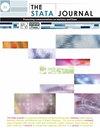Measuring technical efficiency and total factor productivity change with undesirable outputs in Stata
IF 3.2
2区 数学
Q1 SOCIAL SCIENCES, MATHEMATICAL METHODS
引用次数: 2
Abstract
In this article, we introduce two community-contributed data envelopment analysis commands for measuring technical efficiency and productivity change in Stata. Over the last decades, an important theoretical progression of data envelopment analysis, a nonparametric method widely used to assess the performance of decision-making units, is the incorporation of undesirable outputs. Models able to deal with undesirable outputs have been developed and applied in empirical studies for assessing the sustainability of decision-making units. These models are getting more and more attention from researchers and managers. The teddf command discussed in the present article allows users to measure technical efficiency, both radial and nonradial, when some outputs are undesirable. Technical efficiency measures are obtained by solving linear programming problems. The gtfpch command we also describe here provides tools for measuring productivity change, for example, the Malmquist–Luenberger index and the Luenberger indicator. We provide a brief overview of the nonparametric efficiency and productivity change measurement accounting for undesirable outputs, and we describe the syntax and options of the new commands. We also illustrate with examples how to perform the technical efficiency and productivity analysis with the newly introduced commands.在Stata测量技术效率和全要素生产率变化与不良产出
在本文中,我们介绍了两个社区贡献的数据包络分析命令,用于测量Stata的技术效率和生产力变化。在过去的几十年里,数据包络分析(一种广泛用于评估决策单元绩效的非参数方法)的一个重要理论进展是纳入了不期望的产出。已经开发出能够处理不良产出的模型,并将其应用于评估决策单位可持续性的实证研究中。这些模型越来越受到研究者和管理者的关注。本文中讨论的teddf命令允许用户在某些输出不理想时测量径向和非径向的技术效率。通过求解线性规划问题得到了技术效率测度。我们在这里描述的gtfpch命令提供了测量生产力变化的工具,例如Malmquist–Luenberger指数和Luenberge指标。我们简要概述了非参数效率和生产率变化测量方法,并描述了新命令的语法和选项。我们还举例说明了如何使用新引入的命令执行技术效率和生产力分析。
本文章由计算机程序翻译,如有差异,请以英文原文为准。
求助全文
约1分钟内获得全文
求助全文
来源期刊

Stata Journal
数学-统计学与概率论
CiteScore
7.80
自引率
4.20%
发文量
44
审稿时长
>12 weeks
期刊介绍:
The Stata Journal is a quarterly publication containing articles about statistics, data analysis, teaching methods, and effective use of Stata''s language. The Stata Journal publishes reviewed papers together with shorter notes and comments, regular columns, book reviews, and other material of interest to researchers applying statistics in a variety of disciplines.
 求助内容:
求助内容: 应助结果提醒方式:
应助结果提醒方式:


